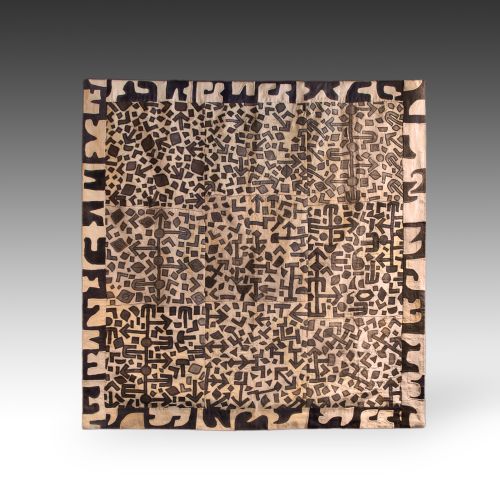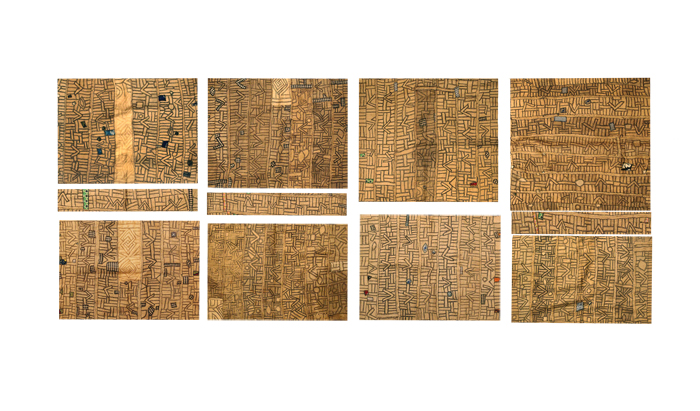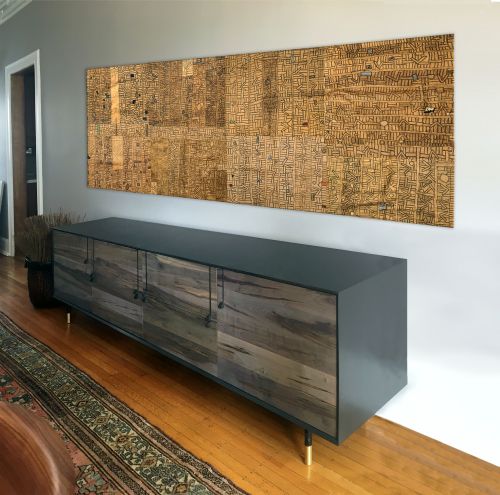Adapting to Modern Design - Repurposing Kuba Cloth
PRIMITIVE - Friday, June 23, 2017 |
|
|
|
By Glen Joffe & Misaki Imagawa
Selecting an effective display method is one of the most challenging aspects of collecting and presenting rare items. For example, a mask looks one way when simply hung on the wall versus being placed on a custom base so it can be displayed as a tabletop object. No matter the type of object being considered; display plays an important role in its appearance; and ultimately, its appreciation. One of the most challenging textiles to display is the long Kuba cloth woven in the Kuba Kingdom deep inside the Democratic Republic of Congo in Central Africa. This African textile can sometimes reach beyond twenty feet; and while aesthetically pleasing and easy to appreciate is difficult to display in its entirety due to its sheer length. It's only natural to ask the question: how can this highly collectible textile be “re-envisioned” and presented as a complete work of art?
In the Kuba Kingdom, men and women work side by side to create highly symbolic cloth known simply worldwide as Kuba cloth. The cloth is fabricated from the leaf of the raffia palm tree, the plant with the longest leaves in the world. The transformation from leaf to textile is easy to understand, but difficult to execute. Discarded leaves are gathered, dried, softened, dyed, and stripped down to individual fibers before being woven into panels or strips that are then embroidered. These units are then sewn expertly together to create the great length of a wrap-around skirt. The slang name for these types of textiles is "Bushoong," a reference to the particular sub-group of the Kuba who weave these textiles.
The weaving of Kuba cloth is a collaborative effort between Kuba artisans, but teamwork isn’t what makes Kuba cloth so valuable and collectible. Instead, it is the stunning abstract geometric designs embroidered on the finished cloth. The designs embroidered or appliquéd on Kuba cloth is a visual language highly appreciated by all in Kuba society. Some say this distinct "visual script" emerged from tribal scarification patterns, crop patterns, or even divine intervention. Regardless of their origins, the patterns have been passed down through generations; and while this patterning can be repetitive, or even spontaneous, it is always unique.
In the past, PRIMITIVE has backed and used Kuba cloth as upholstery for chairs and benches. This simple application transformed basic shapes into stunning works of art; yet it obscured the true nature of Kuba cloth as a collectible textile. It also became impractical as the worldwide value of higher grade, collectible Kuba cloth rose dramatically, primarily because better examples continued to get harder and harder to find. Today, the answer to the question of how to present Kuba cloth in a meaningful and aesthetically pleasing way is to re-purpose the cloth so its unmistakable design can be fully appreciated as a stand alone work of wall-art - a tapestry re-constituted from the original, long cloth.
 |
Because most Bushoong Kuba cloth consists of separate units or panels, it is possible to separate and recombine them into unique visual compositions. They are then stitched together and backed with a pocket added for a suspension bar. The art of rearranging the panels into a size more useful as a wall hanging gives the viewer the opportunity to perceive, at a glance, the colors and dynamics of the patterns. The subtle difference in shades brings an added element of contrast to piece. Generally speaking, finished tapestries composed of re-purposed Kuba cloth produce a powerful effect of intimacy between the viewer and the complex, abstract majesty of the Kuba cloth itself. This type of re-purposing represents a preservation of the original dialogue embedded in the Kuba cloth while allowing collectors a chance to appreciate them in their entirety.
 |
|
|
|
All in all, finished tapestries composed of Kuba cloth illustrate how the classical beauty and tradition found in the craft of the Kuba people can be appreciated in a modern way. Seeing just a small section of a textile compels the viewer to contemplate the greater artistry of the whole, to consider the subtle balance of colors and the exactness of the countless number of stitches found in each cloth. Upon closer examination, even imperfections become attractive; and when you back away and view the tapestry as a whole, one fact is driven home - these textiles emanate and celebrate the hand and heart.
